Toshiba Satellite M645: The Steady March of Progress
by Dustin Sklavos on April 29, 2011 12:50 AM ESTGaming Performance Should Be Better
As a refresher, the NVIDIA GeForce GT 525M with 1GB of DDR3 beating at the heart of the Toshiba M645 is specced to run at 600/1200MHz on the core/shaders, but instead Toshiba runs 21% slower at just 475MHz on the core and 950MHz on the shaders. This not only puts it well below spec, it puts it below even the GeForce GT 420M. It may seem like I'm harping on this way too much, but it oftentimes means the difference between playability and stuttering. Take a look at our "low" preset scores.
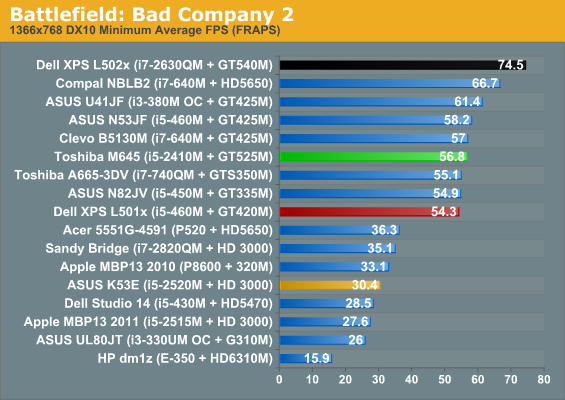
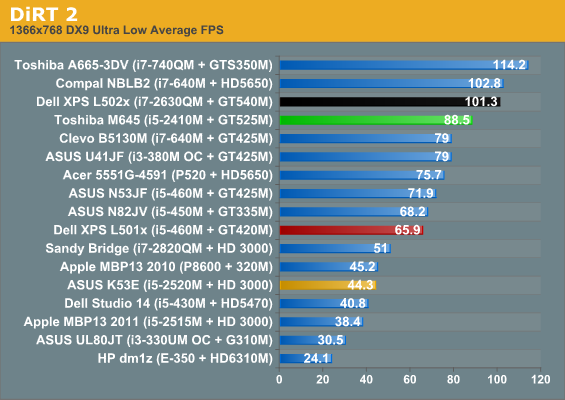
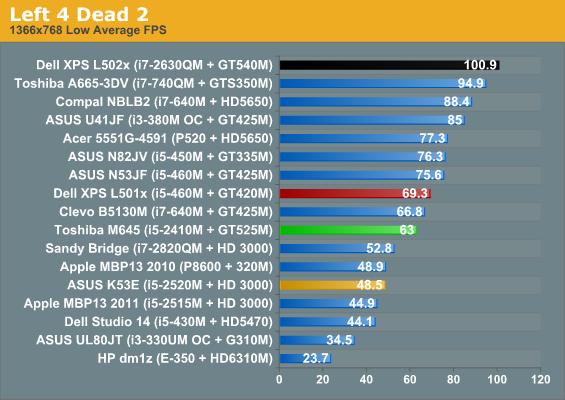
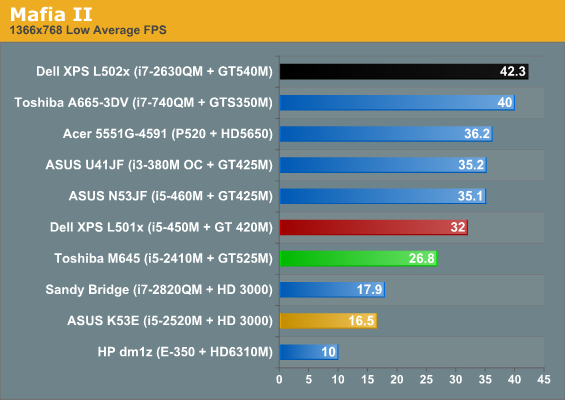
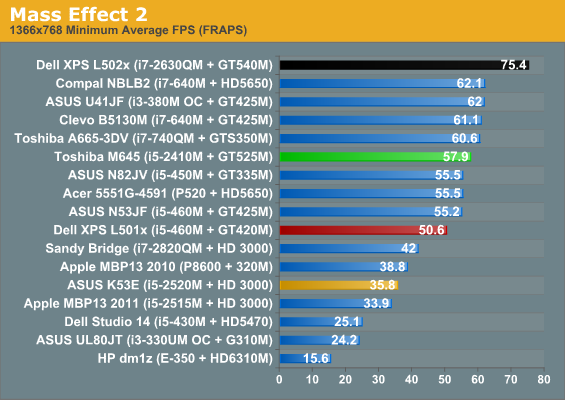
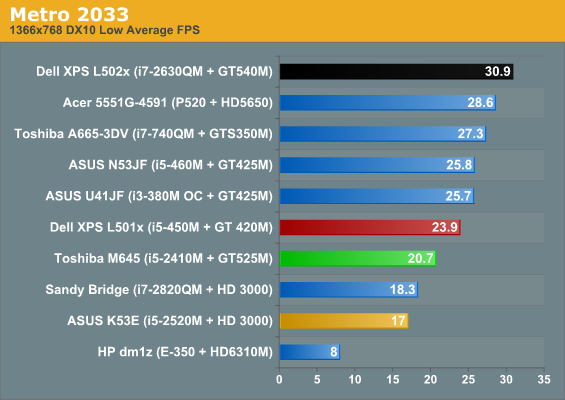
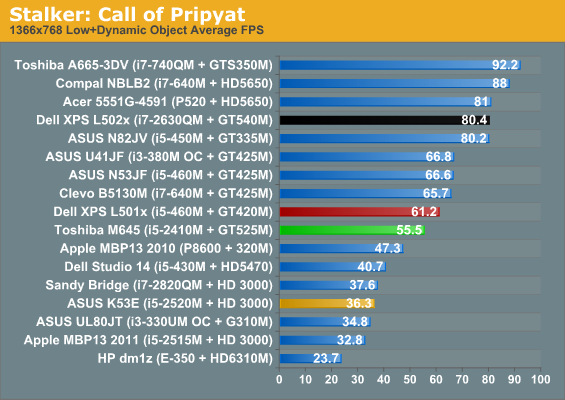
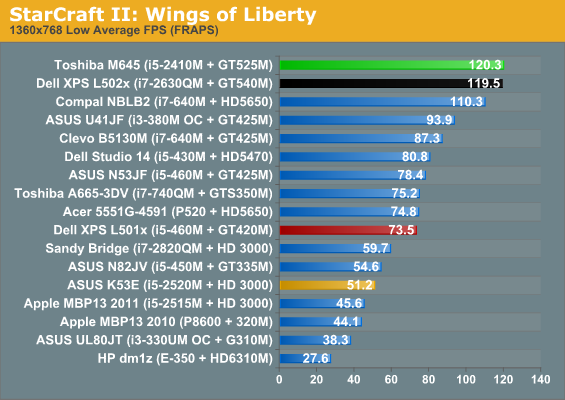
In most situations the M645 doesn't fare too bad, but at these settings there is a tendency towards being CPU-limited that allows the i5-2410M in the M645 to stretch its legs. Still, the clocks claim their first victim in Mafia II, dipping that game below the 30fps mark. We also see the L501x with a GT 420M claiming leads in Left 4 Dead 2, Mafia II, Metro 2033, and STALKER. When we bump settings up to our "medium" preset, watch the tumble the underclocked GT 525M takes.
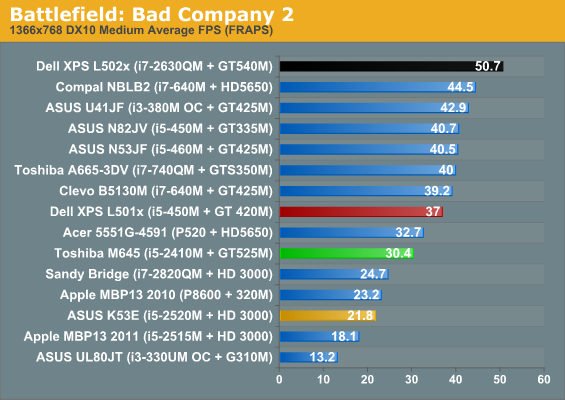
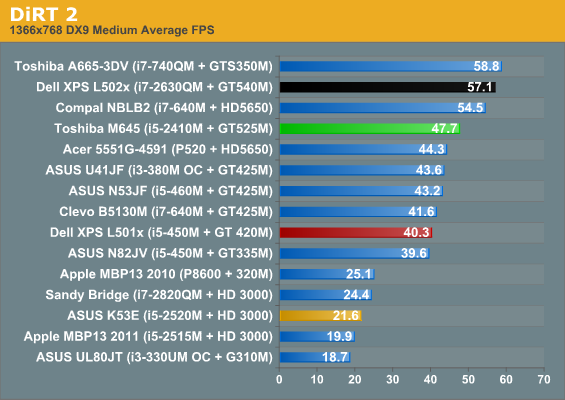
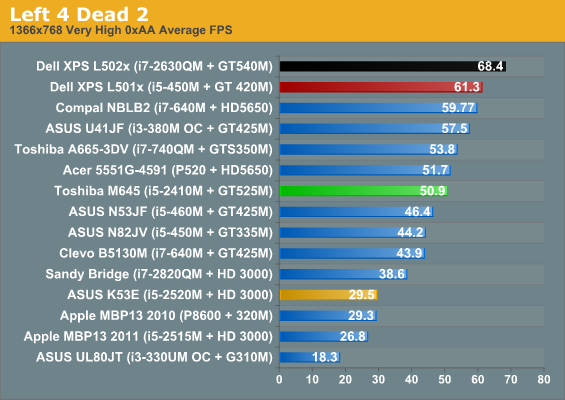
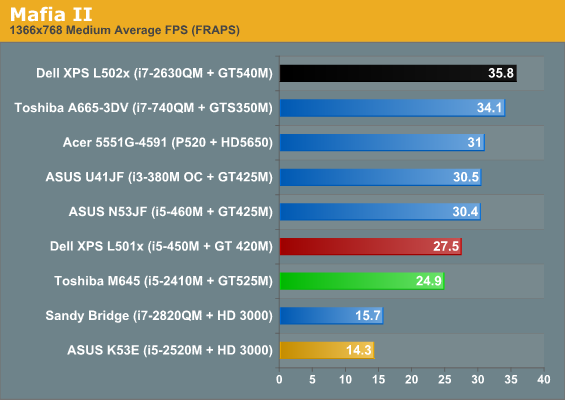

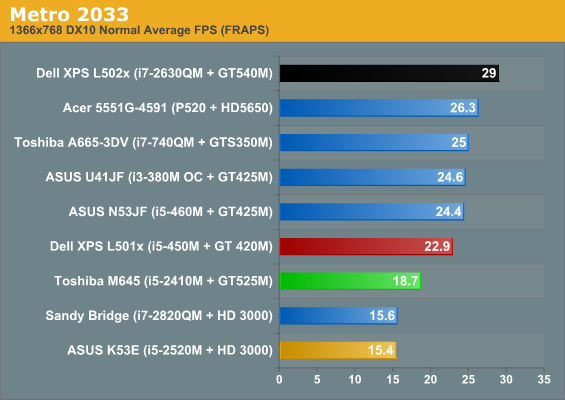
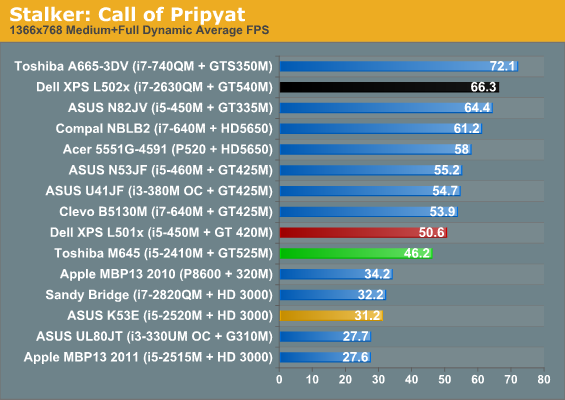
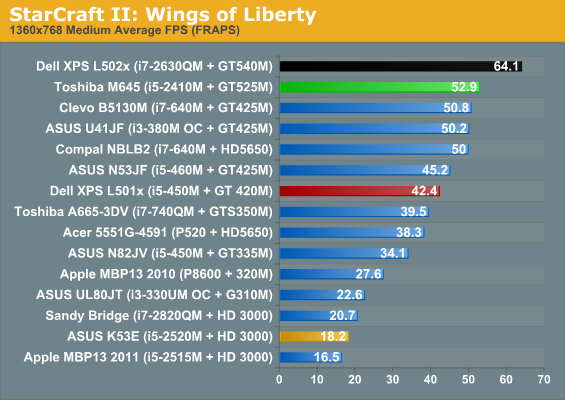
Once we get to Medium detail, the underclocked GT 525M loses ground in a hurry. Situations in more heavily GPU-limited games only get worse; any game where the M645 can't leverage its faster processor in takes a serious hit. The older L501x now leads in Battlefield: Bad Company 2, plus the other four games where it had a lead at Low settings.
Another point of reference is the GT 540M in the L502x; it should be at best about 12% faster than the GT 525M (except when the quad-core CPU in the Dell can help out, e.g. BFBC2), but the leads range from around 20% (DiRT 2 and StarCraft II) up to 55% (Metro 2033), and a maximum lead of 67% in BFBC2. The M645 still manages playable framerates in most of our test suite at medium settings, but the green bar should have been a lot closer to the black bar in the above charts.
Again we note that Left 4 Dead 2 at our medium preset requires you to set "Paged Memory Pool Available" to "Low" on Optimus systems—this appears to be a problem with the Intel HD 3000 drivers, as we had the same issue on the SNB IGP notebooks. It appears to degrade performance about 10-20%, though we can't test with the setting on "High". At over 50FPS, it's not a major concern, but the game does seem to have more HDD thrashing with this setting at Low.










34 Comments
View All Comments
Icabus - Friday, April 29, 2011 - link
I don't know if I speak for everyone, but I would love to see 2 additional graphs. On the performance page a graph showing the current price, or price range for the other comparable offerings would be nice so you could see what kind of performance increase you are getting for the increase in price. I know this would not be easy as the price can very across the internet, and I understand price can change with rebates and sales all the time.The other graph is a little easier, but on the power usage page I would love to see the weight here. Since the different offerings come with different size batteries, it would be nice to see just how much of a difference there is between to offerings when on has a 4xWHr battery and another has a 8xWHr battery.
Chris Peredun - Friday, April 29, 2011 - link
"NVIDIA specifies the 525M to run the core at 600MHz (and thus the 96 CUDA cores at 1.2GHz), but Toshiba has substantially reduced its core clock to just 475MHz (reducing the CUDA cores to a paltry 950MHz). The cut is a brutal one that you'll see reduces performance below even a GeForce GT 420M."Thanks for highlighting this issue on page 1, Dustin.
In a dream world, NVIDIA would come kick them in the groin and tell them not to label or refer to the GPU in this unit as a "GT 525M" when it is *not obeying specs.*
Is there a particular reason we can't have that dream come true? I'm sure there's some country where a "false advertising" suit would land a hit.
Pessimism - Friday, April 29, 2011 - link
I'd love to see a "durability roundup" in which you take all the $699 budget wonder notebooks and put them through a series of impacts, drops, and spills followed by a photographed teardown detailing internal damage to see how these mass produced plastic consumer notebooks stand up to abuse.TegiriNenashi - Friday, April 29, 2011 - link
With processors, memory and the other stuff stagnated these days perhaps it makes sense for vendors to differentiate on their screen offering. Is it hard to comprehend how many users can't stand 16:9?jah1subs - Friday, April 29, 2011 - link
You can complain all you want about 16:9 and it will make absolutely no difference. Several years ago, I noticed a story on digitimes.com that said panel manufacturers realized that they could lay out more 16:9 panels than 16:10 panels in later generation manufacturing plants, perhaps 6th generation. The difference was 5% or 10%I have a question. For those who have seen 14" or 15.6" panels, is 1600x900 more or less readable than 1366x768, all other things being equal (ceteris paribus)?
P.S. ceteris paribus is correctly spelled. I searched it before posting the message.
kmmatney - Friday, April 29, 2011 - link
"I have a question. For those who have seen 14" or 15.6" panels, is 1600x900 more or less readable than 1366x768, all other things being equal (ceteris paribus)?"The answer is: 16:9 sucks
AnnonymousCoward - Saturday, April 30, 2011 - link
Readable? Bigger will always be more readable! The trade off is workspace.btw, the poster didn't even "complain" about 16:9. But I will: it sucks :) And if 1 manufacturer still offered 15.4" 1680x1050 or 14.1" 1400x1050, it would be a huge differentiator and there's a good chance they'd get my business. Make it IPS, too. I'll happily pay the premium.
Letros - Friday, April 29, 2011 - link
Hey guys, long time reader first time poster, great site BTW =)I have a similar model of this laptop, the customized M640, didn't care for the Blu-ray player on the retail model, so I saved a few bucks, while opting for a back-lit keyboard, 7200 HDD, and extended cell battery, came out to $920.
Anyway, I was pretty upset myself when I saw the GT525M at 475 Mhz, however Nvidia System Tools lets you bring the clock back up, I actually have it overclocked at 630/950, up from the 525M spec sheet of 600/900. My GPU temps don't get above 80 C and the laptop does a good job at cooling(had it running for a few hours to confirm stability). My 3dMark 06 was 7600 marks. I don't play too many games on it though, have a desktop for that, but it's nice for some mobile SC2.
I'm satisfied with my purchase, even with the BS clock reduction, a higher res screen would have been nice...
TrackSmart - Friday, April 29, 2011 - link
Good to know that the clock speed is easily modified and that it stays within reasonable temperature limits (for a GPU running at full tilt in a laptop). I don't do any mobile gaming, so I opted for the Portege series (only 3.2 lbs). I also lament the low resolution, low quality displays that Toshiba uses, but I couldn't find any alternatives in the same price range and weight.Beenthere - Friday, April 29, 2011 - link
I'm not gonna buy any InHell product after their criminal convictions.